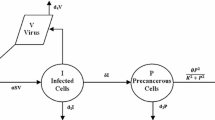The development of cervical cancer cells from normal cells is caused by the human papilloma virus (HPV), and the progression can be described using a population model of the cells and free virus. We develop a mathematical model consisting of five compartments to describe the interactions between the human papilloma virus and four classes of epithelial and basal cells (susceptible, infected, precancerous, and cancerous) of cervix. In our mathematical model, we consider that the disease transmission rate from precancerous to cancerous cells is governed by a response function f(P) according to the risk and our cell immunity power which is dependent on the antibody genes p53 and pRb. So we have considered f(P) as three types of functions linear, Holling type II, and Holling type III. We analyze the local stability of the equilibrium points of each of the types in a comparative way and investigate analytically and numerically the parameters that play an important role in the progression towards the cervical cancer. Furthermore, we have taken some control strategies on the Holling type III functional response based on two types of drugs to eradicate the infected and cancer cell populations.
Similar content being viewed by others
References
C. B. Woodman, S. I. Collins, and L. S. Young, “The natural history of cervical HPV infection: unresolved issues,” Nature Rev. Cancer, 7(1), 11–22 (2007).
V. Kumar et al., Robbins Basic Pathology (8th ed.), Saunders Elsevier (2007), pp. 718–721. ISBN 978-1-4160-2973-1.
G. M. Clifford, et al., “Human papillomavirus types in invasive cervical cancer worldwide: a meta-analysis,” Bri. J. Cancer, 88(1), 63–73 (2003).
T. S. N. Asih, et al., “The dynamics of HPV infection and cervical cancer cells,” Bull. Math. Biol., 78(1), 4–20 (2016). doi: https://doi.org/10.1007/s11538-015-0124-2.
C. Lee and L. A. Laimins, “The differentiation-dependent life cycle of human papillomaviruses in keratinocytes,” in: The Papillomaviruses, R. Garcea, D. Di Maio (eds.), Springer, New York (2007), pp. 45–67.
M. Nowak and R. May, Virus Dynamics, Mathematical Principles of Immunology and Virology, Oxford University Press, New York (2000).
S. Mori, et al., “Replication interference between human papillomavirus types 16 and 18 mediated by heterologous E1 helicases,” Virol. J., 11(1), 11 (2014).
M. Verma, et al., “Modeling the mechanisms by which HIV-associated immunosuppression influences HPV persistence at the oral mucosa,” PLos One, 12(1), e0168133 (2017). doi: org/10.1371/journal.pone.
N. Shaban and H. Mofi, “Modelling the impact of vaccination and screening on the dynamics of Human Papillomavirus infection,” Int. J. Math. Anal., 8(9), 441–454 (2014).
R. Herrero, “Human papillomavirus (HPV) vaccines: limited cross-protection against additional HPV types,” J. Infect. Dis., 199(7), 919–922 (2009).
L. S. Pontryagin, et al., Mathematical Theory of Optimal Processes, Gordon and Breach Science Publishers, New York, London (1986).
G. M. Swan, Application of Optimal Control Theory in Biomedicine, Marcle Decker, Inc, New York & Basel (1984).
S. Chakraborty, J. Pal, S. Chowdhury, and P. K. Roy, The Impact of Vaccination to Control Human Papillomavirus Dynamics, Industrial and Applied Mathematics, Springer, Singapore (2017).
P. K. Roy, S. Chowdhury, and X.-Z. Li, “Saturation effects for CTL mediated control of HIV-1 infection: a mathematical study,” Int. J. Biomath, 6(03) (2013).
Author information
Authors and Affiliations
Corresponding author
Rights and permissions
About this article
Cite this article
Chakraborty, S., Cao, X., Bhattyacharya, S. et al. The Role of HPV on Cervical Cancer with Several Functional Response: a Control Based Comparative Study. Comput Math Model 30, 439–453 (2019). https://doi.org/10.1007/s10598-019-09469-4
Published:
Issue Date:
DOI: https://doi.org/10.1007/s10598-019-09469-4




